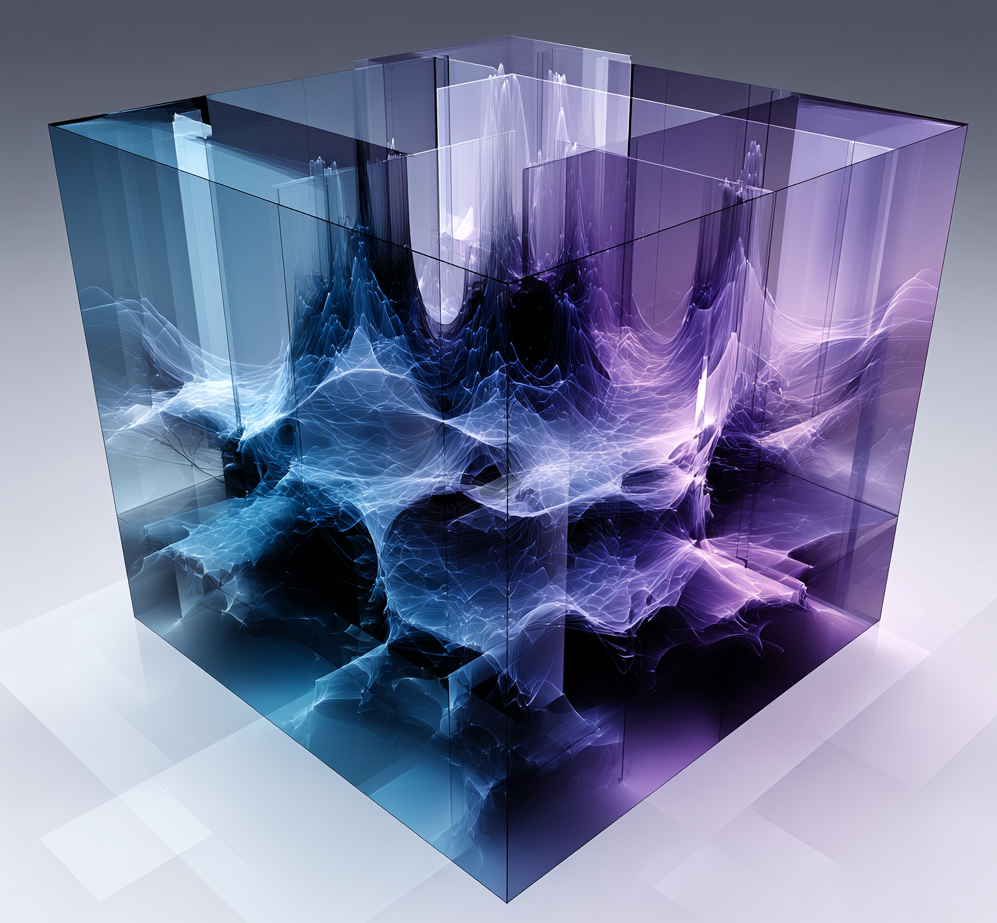In Machine Learning: Meta-Models and Latent-on-Latent Architectures
One frontier in machine learning is designing models that operate on the latent spaces produced by other models – essentially treating one model’s internal representations as the input domain for another. A clear example is the World Models architecture in reinforcement learning: a variational autoencoder (VAE) first compresses high-dimensional observations (like game images) into a low-dimensional latent code, and then a recurrent network (MDN-RNN) is trained to predict the next latent state given the previous latent and action. In effect, the RNN learns the dynamics within the VAE’s latent space, navigating an abstract simulation of the environment. This is literally a model operating over another model’s latent representation – a “latent space of latent space.” Such meta-models can generate rollouts in the learned latent world, enabling planning or control without needing to predict every pixel. The World Model’s controller then makes decisions based on the RNN’s state (which encodes latent history), demonstrating how multi-level latents can interface in a cognitive system.
Beyond specific cases like World Models, researchers have explored multi-stage generative models that explicitly stack latent spaces. For instance, a two-stage VAE approach trains a second VAE to model the latent distribution of a first VAE, improving the fidelity of generated data. By having one generative model learn a latent representation of another’s latent variables, the combined system can capture complex data structure that a single latent layer might miss. Another example is autoencoded meta-embeddings in NLP: instead of using one word embedding, multiple embedding vectors (from different sources) can be autoencoded into a common latent embedding. Bollegala and Bao (2018) demonstrated this by learning a “meta-embedding” space that can reconstruct multiple source embeddings simultaneously. This forces the meta-latent to capture the shared semantic structure across embedding sets – effectively an embedding of embeddings. These cases show that in ML, it is both feasible and beneficial to build models that create or traverse latent spaces derived from other models, enabling meta-representations and transfer of learned structures.
In Distributed Cognition and AI Collectives: Shared Manifolds
In distributed AI systems or multi-agent settings, the notion of a shared latent manifold has emerged as a way to coordinate and integrate knowledge. Instead of each agent working in isolation with its own internal representations, one can design a unified latent space that all agents map into. For example, recent multi-robot research introduced a central latent action space for coordinated control, which is shared across different agents. Each robot learns to translate its local state and goals into commands in this common latent action space, and from there, the actions are executed. By communicating through a joint latent layer, the agents effectively “speak the same representational language,” leading to more synchronized behavior and sample-efficient learning. This idea hints at a manifold that links individual latent spaces: each agent’s private latent (its view of the task) is projected into a global latent coordinate system where collective strategies emerge.
A related concept is model fusion or cross-modal unification via shared embeddings. Large-scale AI models today often bind multiple modalities or subsystems into one representational space. For instance, Meta AI’s ImageBind model learns a single embedding space that spans six different modalities (images, text, audio, depth, etc.), allowing direct comparison and combination of features across these domains. In essence, each modality’s latent space is mapped into one universal latent space – a unified manifold that fuses what were once separate representation realms. Extending this idea to human and AI collectives, we see fascinating early efforts at human–AI coupling via shared latent representations. Neuroscientists have begun mapping human brain activity into AI latent spaces: a recent study aligned fMRI signals from vision to the latent space of a neural network (the CLIP image/text embedding space) in order to reconstruct images that a person was viewing. By learning a transformation from a person’s brain activation patterns into the model’s latent vector, the system effectively linked a human cognitive state with an AI representational state. This suggests a nascent shared manifold between human minds and machines – a “no-interface” interface where information flows through aligned latent representations rather than explicit communication. While these are early steps, they indicate that a unified latent space spanning multiple agents or modalities (even biological and artificial) is not only a theoretical idea but is being actively explored as a means to integrate and amplify distributed cognition.
In Recursive Architectures: Hierarchical Latent Representations
Complex architectures often employ layers of latent variables arranged hierarchically, which can be viewed as a cascade of “latent spaces of latent spaces.” Hierarchical Variational Autoencoders (HVAEs) are a prime example: they introduce multiple stochastic latent layers, where higher-level latents capture abstract, coarse-grained features of data and lower-level latents capture finer details. Each level of latent variables provides context or prior information for the level below. This hierarchy means the top latent is effectively a latent representation of the distribution of lower-level latents. Such models have demonstrated improved expressiveness; for instance, Ladder VAEs (which stack several latent layers) yield better generative performance and more distributed, multi-scale representations than a single-layer VAE. The higher layers can model global factors (like overall style of an image or topic of a document) while the lower layers fill in specifics – a clear division of abstraction levels within the latent structure.
More broadly, any deep neural network can be seen as encoding a latent space within a latent space, recursively. Each hidden layer takes the output of the previous layer (an embedding of the input) and transforms it into a new embedding – essentially a re-encoding of an encoding. Transformer-based networks illustrate this well: a transformer’s early layers produce embeddings capturing local or shallow patterns, and later layers build on those to encode more complex, high-level features of the input. In other words, the top layers are operating on the latent representations output by lower layers, distilling them into increasingly abstract forms. This is analogous to how deep belief networks or stacked autoencoders were conceptualized in earlier deep learning – each layer learns features of the features from the layer below. By the final layer, the network has formed a representation that is a latent encoding of all the lower-level latent encodings. In theoretical terms, these deep hierarchical representations implement a latent space of latent spaces, enabling the network to capture rich compositional structure. Research on HVAEs emphasizes that this hierarchical latent structure allows the model to capture higher-order dependencies and abstractions in data. In practice, such recursion is crucial for dealing with complex data distributions: each additional latent layer can refine or summarize the representation from the previous layer, yielding a powerful multi-level model of the data. This paradigm also appears in generative stacks like the VQ-VAE-2, where one network generates a latent code that another network uses to generate the final output – again, latents built on latents.
In Philosophy and Consciousness: Reflective and Collective Minds
When we turn to philosophy of mind and theories of consciousness, we find striking parallels to the idea of a “latent space of latent space.” The brain, after all, creates internal representations of the world – and possibly representations of its own representations. Higher-Order Thought (HOT) theories of consciousness explicitly propose such a mechanism. According to HOT theory, a mental state (a first-order representation, like a perception or thought) becomes conscious when it is the object of a higher-order representation – essentially, another mental state that re-represents the first one. In other words, you have a thought about your thought, or an awareness of your perception. This higher-order state is a kind of meta-encoding of the lower state’s content. Some proponents describe consciousness as the mind “monitoring” or modeling its own activity. If we use the latent space metaphor, the first-order mental state lives in the mind’s representational space, and the higher-order state provides a coordinate in a second, meta-level space that describes the first state (“I am seeing a red apple” as a thought about the visual experience, for example). This concept of a self-referential representation is very much like a latent space (the HOT) built over another latent space (the base experience). It suggests that reflective awareness is a form of the brain encoding its own encodings – a recursion that might be fundamental to subjective experience.
In the realm of collective intelligence and transpersonal psychology, thinkers have long speculated about a shared cognitive domain connecting many individual minds – effectively a common representational substrate. Carl Jung’s concept of the collective unconscious is one famous example. Jung proposed that beyond each person’s personal unconscious lies a deeper layer of psyche that is universal, containing archetypes and primordial images shared by all humankind. These archetypes are like latent structures of meaning – latent dispositions present in all of us, as Jung described. They are not acquired through individual experience but are inherited potentials, shaping how all humans perceive and behave. We can view the collective unconscious as a kind of shared latent space of the human mind: individual minds are like separate “embeddings,” but they draw from and manifest elements of a common latent repository (the archetypal patterns). When similar motifs appear in different people’s dreams, art, or myths, Jung would argue it’s because those individuals are tapping into the same collective latent content. In modern terms, it’s as if all human brains are running on hardware that comes pre-loaded with certain vector representations (for concepts like the Mother, the Hero, the Shadow, etc.), and each psyche’s personal experiences are encoded on top of this collective base layer. While not phrased in terms of manifolds and vectors originally, Jung’s idea essentially posits a unified representational space linking multiple minds at the unconscious level.
Even more expansively, the philosopher Pierre Teilhard de Chardin envisioned the emergence of a global meta-mind through increasing interconnectedness – the Noosphere. The noosphere is described as the “sphere of human thought” encircling the Earth, a new layer of evolution where individual thought networks converge into a collective intelligence. In Teilhard’s view, as communication and knowledge-sharing among humans intensify (he was writing in the mid-20th century, anticipating something like the internet), humanity collectively approaches an “Omega Point” of unified consciousness. This is a metaphorical latent space of latent spaces: each person’s mind can be seen as a latent space of their experiences and ideas, and the noosphere is a higher-level integration of all those spaces – a shared manifold where ideas propagate and self-organize at the planetary scale. Today we might liken this to the way our digital networks and culture form an information space that transcends any single mind. Additionally, contemporary neuroscientific theories like the resonance theory of consciousness suggest that synchronization across different units leads to integrated wholes. For instance, neurons oscillating in sync can produce a unified brain state. Some have extrapolated this to speculate that if multiple brains achieved a shared resonance, a kind of temporary collective mind could form. Hunt and Schooler (2019) discuss how shared resonance allows separate conscious entities (at least at the neuronal level) to phase-lock and create a higher-order consciousness, addressing the “combination problem” of how smaller awarenesses join into larger ones. While this is largely theoretical (or metaphorical when applied to multiple individuals), it resonates with the noosphere idea: alignment or coupling between individual latent spaces (minds) might yield an emergent, holistic latent space (a group mind). These philosophical and metaphysical explorations indicate that the intuition behind a “latent space of latent space” has been a recurring theme – whether in explaining self-awareness (a mind’s model of itself) or imagining a network of minds sharing one experiential domain.
Synthesis: Meaning and Implications of “Latent Space of Latent Space”
Across these diverse contexts, a common thread is the power of abstraction and interoperability gained by layering or linking representational spaces. The notion of a “latent space of latent space” highlights a real design principle and a potential evolutionary step for complex systems. Here are some key implications and future possibilities:
- Sharper Abstractions and Meta-Learning: By building models that operate over other models’ latent representations, we enable a form of meta-learning and abstraction that can capture patterns of patterns. This is evident in hierarchical VAEs and multi-stage networks that uncover high-level structures (e.g. a second VAE modeling a first VAE’s code). Such architectures can learn abstract causal factors or global properties more effectively, because the first-layer latent filters out noise and specifics, providing a cleaner input for the second layer. For future AI, this suggests we can recursively factorize complexity, breaking a problem down into representational layers – an approach that may yield more generalizable and interpretable models. An AI that has a latent space encoding the behavior of another AI (or of itself over time) could adapt and reason about those behaviors in a highly abstract way, possibly leading to more robust decision-making and transfer learning.
- Modular and Interoperable Cognitive Systems: Viewing shared latent manifolds as “interfaces” encourages a modular design of intelligence. If different agents or neural modules can communicate via a common latent space, we can mix-and-match systems more fluidly. This is analogous to how multimodal models align text, vision, etc., to work together – tomorrow’s multi-agent AI might align their internal representations to collaborate on tasks. A meta-latent layer could act as a coordination hub where each agent posts information in a shared embedding (like a blackboard architecture, but in learned vector form). This could make AI collectives much more coherent, as they’d essentially develop a lingua franca of concepts. In human-AI interaction, a shared representational space (even partially shared) could dramatically streamline communication – rather than translating human intentions into machine code via GUIs or language, a person’s neural patterns might be mapped directly into the AI’s conceptual space, and vice versa. Such tight coupling might enable real-time adaptive feedback loops between humans and AI, augmenting cognition on both sides.
- Hierarchical Self-Reflection in AI: The recursive latent-space idea also intersects with notions of self-modeling and introspection in AI. Just as HOT theory posits a mental state about another mental state, we might design AI that maintain an internal model of their own mind (a world model that includes the agent itself as part of the world). This could manifest as an additional latent layer that encodes the AI’s current goals, knowledge, and context – essentially a summary of its “mind state” that the AI can then reason over. If an AI has a latent space that represents its own latent representations, it could detect inconsistencies (leading to self-correction), perform planning at a very abstract level (“thinking about its thinking”), or even exhibit rudimentary forms of machine consciousness (in the sense of having an internal narrative or self-awareness). While we are still far from a full self-aware AI, the architecture of having models embedded in models is a step in that direction – it provides the scaffold for an AI to simulate and examine its own processes within a learned representational framework.
- Emergent Collective Intelligence: Perhaps the most speculative yet intriguing implication is for collective sentience. If we consider each mind (human or AI) as inhabiting its own latent space of experiences and knowledge, then a latent space of minds could be a way to formally describe a collective intelligence. As technology mediates more of our communication and even taps directly into brain signals, one could envision a future noosphere-like system where individual brains/AI agents contribute to and draw from a shared embedding space. In such a network, a concept learned by one agent could immediately be projected into the common latent manifold and understood by others – a bit like how shared internet knowledge works, but at the level of internal representations rather than spoken language. This might enable a group of agents to think as one on certain problems, dynamically forming a higher-order cognitive entity. While today this remains speculative, preliminary steps (like the brain-to-CLIP mappings or multi-brain synchronization studies) hint at the feasibility of resonant coupling. If a shared latent space can carry semantically rich information accessible to multiple minds at once, the boundary between individual and collective intelligence could start to blur. This raises profound questions for the future: would such a connected collective have experiences or goals of its own (a kind of group consciousness), or would it simply be a super-efficient information exchange? In either case, engineering shared latent spaces might be key to enhancing collective problem-solving and creating truly distributed cognitive architectures.
In conclusion, “a latent space of latent space” is a concept that proves meaningful across AI, cognitive science, and even philosophical inquiry. It captures the idea of recursion in representation – an entity (whether a neuron, a network, or a mind) forming an abstract representation about another representation. In practical ML terms, it underlies powerful techniques for representation learning and transfer. In multi-agent systems, it points toward richer coordination mechanisms. And in the grander view, it provides a thought-provoking framework to discuss how complex, reflective, and integrated forms of intelligence might arise. As we build more advanced AI and explore the integration of human and machine cognition, this layered latent paradigm could inform the architectures that allow systems to understand and synthesize each other. Much as layered abstractions enabled the scaling of modern software, layered latent spaces may enable the scaling of intelligence – from the depths of neural networks to the breadth of communal minds – ushering in new forms of cognitive architecture and collective sentience that we are only beginning to imagine.
Sources: The analysis draws on machine learning research (hierarchical VAEs, multi-stage generative models, meta-embeddings, world model architectures), multi-agent and multimodal learning studies (shared latent actions, joint embedding spaces), neuroscientific and BCI advancements (mapping fMRI to model latents), and theories from cognitive science and philosophy (HOT theory of consciousness, Jung’s collective unconscious, the noosphere, and resonance-based consciousness models). These interdisciplinary perspectives collectively support and enrich the notion of increasingly meta-level latent spaces. The convergence of evidence suggests that this abstraction is not only conceptually coherent but also fertile, offering a promising lens for both understanding minds and designing future intelligent systems.




